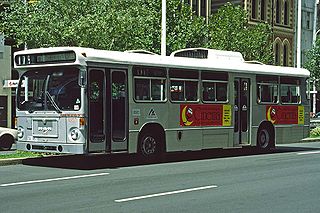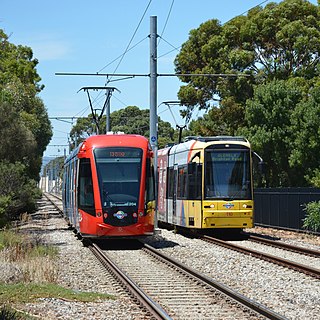
The Melbourne tramway network is a tramway system serving the city of Melbourne, Victoria, Australia. The tramway network is centred around the Melbourne central business district (CBD) and consists of approximately 1,700 tram stops across 24 routes. It is the largest operational urban tram network in the world and one of the most used, with more than 500 trams and 250 kilometres of double tram track. It carried 154.8 million passengers over the year 2023-24. Trams are the second most utilised form of public transport in Melbourne after the city's metropolitan commuter railway network.

Adelaide Metro is the public transport system of the Adelaide area, around the capital city of South Australia. It is an intermodal system offering an integrated network of bus, tram, and train services throughout the metropolitan area. The network has an annual patronage of 79.9 million, of which 51 million journeys are by bus, 15.6 million by train, and 9.4 million by tram. The system has evolved heavily over the past fifteen years, and patronage increased dramatically during the 2014–15 period, a 5.5 percent increase on the 2013 figures due to electrification of frequented lines.

TransAdelaide was a publicly owned cooperation in Adelaide, South Australia, and operated the city's suburban rail, tram and bus services. It took responsibilities from the State Transport Authority in July 1994.

The Glenelg tram line is a tram/light rail line in Adelaide. Apart from a short street-running section in Glenelg, the line has its own reservation, with minimal interference from road traffic.

The State Transport Authority (STA) was the government agency which controlled public transport in South Australia between 1974 and 1994.

Metro Tasmania, commonly called Metro, a Tasmanian Government business enterprise, is the largest bus operator in the state of Tasmania, Australia, with operations in three of the four largest urban centres of Hobart, Launceston, and Burnie. Urban services in Devonport are provided by a private operator, Kinetic. Services are provided by Metro under a range of urban and non-urban contracts with the Transport Commission, a division within the Department of State Growth.

The Adelaide tramway network served much of the inner suburbs and a few outer suburbs of Adelaide, Australia, from 1878 up until the 1950s when the network started to decline. The sole Glenelg light rail line was the only route to survive the closures and has remained in operation ever since. After falling into a state of disrepair and neglect, it underwent major upgrades and extensions in the 2000s with a new tram fleet and major extensions.

Buses in Adelaide are the most extensive service of the South Australian capital's public transport system, the Adelaide Metro. A large fleet of diesel, hybrid diesel-electric, and natural gas powered buses operate services which typically terminate in the city-centre or at a suburban interchange. Buses get priority on many roads and intersections, with dedicated bus lanes and 'B'-light bus only phases at many traffic lights.

The earliest trams in Australia operated in the latter decades of the 19th century, hauled by horses or "steam tram motors". At the turn of the 20th century, propulsion almost universally turned to electrification, although cable trams lingered in Melbourne. In cities and towns that had trams, they were a major part of public transport assets.
The Holdfast Bay railway line was a railway in western Adelaide, built in 1880 to compete with the Adelaide, Glenelg & Suburban Railway Company. The line started at the Adelaide railway station, on the northern edge of the central business district, and proceeded to the northern edge of Mile End, South Australia immediately to the west of the city. From there the line headed south-west to the seaside suburb of Glenelg.

The Adelaide trolleybus system formed part of the public transport network in Adelaide, South Australia from 1932 until 1963.

The Hobart trolleybus system operated in Hobart, Tasmania, Australia from 1935 until 1968.

The city of Geelong in Victoria, Australia, operated an extensive tramway system from 1912 until 1956, when the service was replaced by buses. Unlike Victoria's other major regional cities, Ballarat and Bendigo, which have kept some track and trams as tourist attractions, no trams or tracks remain in Geelong.

Sir William George Toop Goodman KBE MICE MIEE MIEAust, was an engineer and administrator who supervised the installation of New Zealand's first electric tramway and went on to oversee the foundation and growth of the Municipal Tramways Trust in Adelaide, South Australia.

The Tramway Museum, St Kilda is Australia's principal museum of the 19th and 20th century trams of Adelaide, South Australia. It is situated at St Kilda, 24 kilometres north of the centre of Adelaide. It is operated by the Australian Electric Transport Museum (SA) Inc., a not-for-profit volunteer organisation affiliated with the Council of Tramway Museums of Australasia. It is dedicated to the study, conservation and restoration of trams that were used in Adelaide or built there, and likewise with a small bus and trolleybus collection.Trams provide unlimited free rides for visitors on payment of the entrance fee. They operate along a 1.6 kilometres purpose-built track between the museum and a large adventure playground.
This article describes the tram types in Adelaide that have operated for the past 146 years: from early days when they undertook a major share of the public transport task before car ownership was well established; through the 49-year period when only one tram line operated; to the city's 21st-century tramways revival.

The H1 type Adelaide tram was a one-off tram built by JA Lawton & Sons in 1952 for the Municipal Tramways Trust (MTT), Adelaide.

This article – one of several about Adelaide’s tramways – covers the three decades before the 1910s when horses provided the motive power for all trams over a 74 miles network. Links to an overview and other articles are in the following panel.

This article – one of several about Adelaide’s trams – describes the development of new lines and operation of new trams since 2005. Links to an overview and other articles are in the following panel.
The Glenelg railway line is a former railway line in Adelaide, South Australia.






















